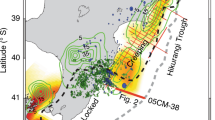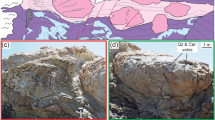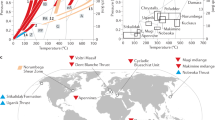Abstract
Seismic and geodetic observations in subduction zone forearcs indicate that slow earthquakes, including episodic tremor and slip, recur at intervals of less than six months to more than two years1,2. In Cascadia, slow slip is segmented along strike3 and tremor data show a gradation from large, infrequent slip episodes to small, frequent slip events with increasing depth of the plate interface4. Observations5,6,7 and models8,9 of slow slip and tremor require the presence of near-lithostatic pore-fluid pressures in slow-earthquake source regions; however, direct evidence of factors controlling the variability in recurrence times is elusive. Here we compile seismic data from subduction zone forearcs exhibiting recurring slow earthquakes and show that the average ratio of compressional (P)-wave velocity to shear (S)-wave velocity (vP/vS) of the overlying forearc crust ranges between 1.6 and 2.0 and is linearly related to the average recurrence time of slow earthquakes. In northern Cascadia, forearc vP/vS values decrease with increasing depth of the plate interface and with decreasing tremor-episode recurrence intervals. Low vP/vS values require a large addition of quartz in a mostly mafic forearc environment10,11. We propose that silica enrichment varying from 5 per cent to 15 per cent by volume from slab-derived fluids and upward mineralization in quartz veins12 can explain the range of observed vP/vS values as well as the downdip decrease in vP/vS. The solubility of silica depends on temperature13, and deposition prevails near the base of the forearc crust11. We further propose that the strong temperature dependence of healing and permeability reduction in silica-rich fault gouge via dissolution–precipitation creep14 can explain the reduction in tremor recurrence time with progressive silica enrichment. Lower gouge permeability at higher temperatures leads to faster fluid overpressure development and low effective fault-normal stress, and therefore shorter recurrence times. Our results also agree with numerical models of slip stabilization under fault zone dilatancy strengthening15 caused by decreasing fluid pressure as pore space increases. This implies that temperature-dependent silica deposition, permeability reduction and fluid overpressure development control dilatancy and slow-earthquake behaviour.
This is a preview of subscription content, access via your institution
Access options
Subscribe to this journal
Receive 51 print issues and online access
$199.00 per year
only $3.90 per issue
Buy this article
- Purchase on Springer Link
- Instant access to full article PDF
Prices may be subject to local taxes which are calculated during checkout



Similar content being viewed by others
References
Schwartz, S. Y. & Rokosky, J. M. Slow slip events and seismic tremor at circum-Pacific subduction zones. Rev. Geophys. 45, RG3004 (2007)
Beroza, G. C. & Ide, S. Slow earthquakes and nonvolcanic tremor. Annu. Rev. Earth Planet. Sci. 39, 271–296 (2011)
Brudzinski, M. R. & Allen, R. M. Segmentation in episodic tremor and slip all along Cascadia. Geology 35, 907–910 (2007)
Wech, A. G. & Creager, K. C. A continuum of stress, strength and slip in the Cascadia subduction zone. Nature Geosci. 4, 624–628 (2011)
Shelly, D. R., Beroza, G. C., Ide, S. & Nakamula, S. Low-frequency earthquakes in Shikoku, Japan, and their relationship to episodic tremor and slip. Nature 442, 188–191 (2006)
Audet, P., Bostock, M. G., Christensen, N. I. & Peacock, S. M. Seismic evidence for overpressured subducting oceanic crust and megathrust fault sealing. Nature 457, 76–78 (2009)
Song, T.-R. A. et al. Subducting slab ultra-slow velocity layer coincident with silent earthquakes in southern Mexico. Science 324, 502–506 (2009)
Liu, Y. & Rice, J. R. Spontaneous and triggered aseismic deformation transients in a subduction fault model. J. Geophys. Res. 112, B09404 (2007)
Segall, P., Rubin, A. M., Bradley, A. M. & Rice, J. R. Dilatant strengthening as a mechanism for slow slip events. J. Geophys. Res. 115, B12305 (2010)
Christensen, N. I. Poisson’s ratio and crustal seismology. J. Geophys. Res. 101, 3139–3156 (1996)
Ramachandran, K. & Hyndman, R. D. The fate of fluids released from subducting slab in northern Cascadia. Solid Earth 3, 121–129 (2012)
Breeding, C. M. & Ague, J. J. Slab-derived fluids and quartz-vein formation in an accretionary prism, Otago Schist, New Zealand. Geology 30, 499–502 (2002)
Manning, C. E. The solubility of quartz in H2O in the lower crust and upper mantle. Geochim. Cosmochim. Acta 58, 4831–4839 (1994)
Giger, S. B., Tenthorey, E., Cox, S. F. & Fitz Gerald, J. D. Permeability evolution in quartz gouges under hydrothermal conditions. J. Geophys. Res. 112, B07202 (2007)
Liu, Y. Numerical simulations on megathrust rupture stabilization under strong dilatancy strengthening in slow slip region. Geophys. Res. Lett. 40, 1311–1316 (2013)
Shen, Z.-K. et al. Pole-tide modulation of slow slip events at circum-Pacific subduction zones. Bull. Seismol. Soc. Am. 95, 2009–2015 (2005)
Lowry, A. R. Resonant slow fault slip in subduction zones forced by climatic load stress. Nature 442, 802–805 (2006)
Pollitz, F. F., Wech, A. G., Kao, H. & Bürgmann, R. Annual modulation of non-volcanic tremor in northern Cascadia. J. Geophys. Res. 118, 2445–2459 (2013)
Hansen, R. T. J., Bostock, M. G. & Christensen, N. I. Nature of the low velocity zone in Cascadia from receiver function waveform inversion. Earth Planet. Sci. Lett. 337–388, 25–38 (2012)
Audet, P. & Schwartz, S. Y. Hydrologic control of forearc strength and seismicity in the Costa Rican subduction zone. Nature Geosci. 6, 852–855 (2013)
Audet, P. et al. Slab morphology in the Cascadia fore arc and its relation to episodic tremor and slip. J. Geophys. Res. 115, B00A16 (2010)
Peacock, S. M., Christensen, N. I., Bostock, M. G. & Audet, P. High pore pressures and porosity at 35 km depth in the Cascadia subduction zone. Geology 39, 471–474 (2011)
Lowry, A. R. & Pérez-Gussinyé, M. The role of crustal quartz in controlling Cordilleran deformation. Nature 471, 353–357 (2011)
Kern, H. Elastic-wave velocity in crustal and mantle rocks at high pressure and temperature: the role of the high-low quartz transition and of dehydration reactions. Phys. Earth Planet. Inter. 29, 12–23 (1982)
Sillitoe, R. H. Major gold deposits and belts of the North and South American Cordillera: distribution, tectonomagmatic settings, and metallogenic considerations. Econ. Geol. 103, 663–687 (2008)
Wada, I. Wang. K., He, J. & Hyndman, R. D. Weakening of the subduction interface and its effects on surface heat flow, slab dehydration, and mantle wedge serpentinization. J. Geophys. Res. 113, B04402 (2008)
Dempsey, D. E., Rowland, J. V., Zyvoloski, G. A. & Archer, R. A. Modeling the effects of silica deposition and fault rupture on natural geothermal systems. J. Geophys. Res. 117, B05207 (2012)
Fisher, D. M. & Brantley, S. L. The role of silica redistribution in the evolution of slip instabilities along subduction interfaces: constraints from the Kodiak accretionary complex, Alaska. J. Struct. Geol. doi:10.1016/j.jsg.2014.03.010. (in the press)
Frederiksen, A. W. & Bostock, M. G. Modelling teleseismic waves in dipping, anisotropic structures. Geophys. J. Int. 141, 401–412 (2000)
Hayes, G. P., Wald, D. J. & Johnson, R. L. Slab1.0: a three-dimensional model of global subduction zone geometries. J. Geophys. Res. 117, B01302 (2012)
Frederiksen, A. W., Folsom, H. & Zandt, G. Neighbourhood inversion of teleseismic Ps conversions for anisotropy and layer dip. Geophys. J. Int. 155, 200–212 (2003)
Wallace, L. M. & Beavan, J. Diverse slow slip behaviour at the Hukirangi subduction margin, New Zealand. J. Geophys. Res. 115, B12402 (2010)
Heki, K. & Kataoka, T. On the biannually repeating slow-slip events at the Ryukyu Trench, southwestern Japan. J. Geophys. Res. 113, B11402 (2008)
Jiang, Y. et al. Slow slip events in Costa Rica detected by continuous GPS observations, 2002-2011. Geochem. Geophys. Geosyst. 13, Q04006 (2012)
Obara, K. Characteristics and interactions between non-volcanic tremor and related slow earthquakes in the Nankai subduction zone, southwest Japan. J. Geodyn. 52, 229–248 (2011)
Vergnolle, M. et al. Slow slip events in Mexico revised from the processing of 11 year GPS observations. J. Geophys. Res. 115, B08403 (2010)
DeShon, H. R. et al. Seismogenic zone structure beneath the Nicoya Peninsula, Costa Rica, from 3D local earthquake P- and S- wave tomography. Geophys. J. Int. 164, 109–124 (2006)
Reyners, M., Eberhart-Phillips, D., Stuart, G. & Nishimura, Y. Imaging subduction from the trench to 300 km depth beneath the central North Island, New Zealand, with Vp and Vp/Vs. Geophys. J. Int. 165, 565–583 (2006)
Matsubara, M., Obara, K. & Kasahara, K. High Vp/Vs zone accompanying non-volcanic tremors and slow slip events beneath southwestern Japan. Tectonophysics 472, 6–17 (2009)
Huesca-Perez, E. & Husker, A. Shallow travel-time tomography below southern Mexico. Geofis. Int. 51, 281–291 (2012)
Ansell, J. H. & Bannister, S. C. Shallow morphology of the subducted Pacific plate along the Hikurangi margin. Phys. Earth Planet. Inter. 93, 3–20 (1996)
Acknowledgements
Data used in this study come from the Japan Meteorological Agency, New Zealand National Seismograph Network, and the Tectonic Observatory (Caltech). Funding for this work comes from the Natural Science and Engineering Research Council (Canada) and the Miller Institute for Basic Research in Science (University of California, Berkeley). We thank N. Beeler, A. Rubin and P. Ampuero for discussions and comments.
Author information
Authors and Affiliations
Contributions
P.A. performed data processing and inversion. Both P.A. and R.B. contributed to the interpretations and preparation of the final manuscript.
Corresponding author
Ethics declarations
Competing interests
The authors declare no competing financial interests.
Extended data figures and tables
Extended Data Figure 1 Examples of receiver functions and inversion results for each subduction zone.
In a–c the slab contours from refs 30 and 41 are in yellow, contours of slow-slip patches from ref. 2 are in light green, contours and epicentres of tremors from ref. 2 are in purple, and station locations used in this study are shown as inverted red triangles. For a subset of stations (PLAY, PXZ and IGK, identified by the blue squares on the maps) we show the observed (top, A) and modelled (bottom, B) radial receiver functions ordered by back-azimuth and, for each back-azimuth, by slowness of the incoming P wave. c, A slice through model misfits, with warm colours indicating low values, showing the vP/vS of forearc crust versus the vP/vS of the low-velocity zone. The star shows the minimum value of the misfit plot (best-fitting value).
Rights and permissions
About this article
Cite this article
Audet, P., Bürgmann, R. Possible control of subduction zone slow-earthquake periodicity by silica enrichment. Nature 510, 389–392 (2014). https://doi.org/10.1038/nature13391
Received:
Accepted:
Published:
Issue Date:
DOI: https://doi.org/10.1038/nature13391
This article is cited by
-
Si- versus Mg-metasomatism at the crust–mantle interface: insights from experiments, natural observations and geochemical modeling
Progress in Earth and Planetary Science (2023)
-
A review of shallow slow earthquakes along the Nankai Trough
Earth, Planets and Space (2023)
-
Fluid transport and storage in the Cascadia forearc influenced by overriding plate lithology
Nature Geoscience (2022)
-
Slab-derived fluid storage in the crust elucidated by earthquake swarm
Communications Earth & Environment (2022)
-
In-situ Raman spectroscopic analysis of dissolved silica structures in Na2CO3 and NaOH solutions at high pressure and temperature
Contributions to Mineralogy and Petrology (2022)
Comments
By submitting a comment you agree to abide by our Terms and Community Guidelines. If you find something abusive or that does not comply with our terms or guidelines please flag it as inappropriate.



